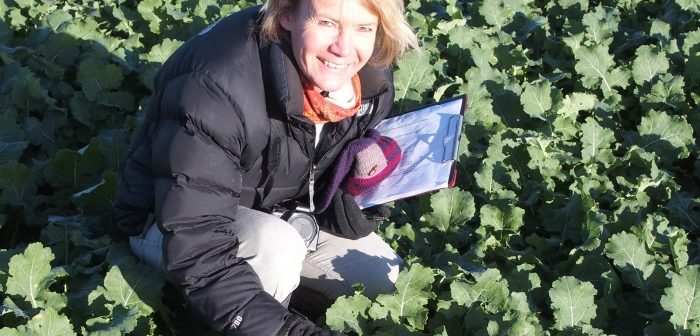Oilseed rape growers and agronomists quiz experts about several aspects of growing oilseed rape. One of the most common is about good establishment, closely followed by weed control and, of course yield.
“Growing Clearfield oilseed rape ticks most of the boxes that growers are questioning now. It is no longer a niche crop, grown to control difficult cruciferous weeds, but an easier, more practical way of growing a reliable high yielding rape crop,” says BASF Business development manager Clare Tucker.
BASF’s Clearfield production system combines hybrid rape seed varieties with a high quality post-emergence herbicide. Using conventional plant breeding techniques, rape varieties have been developed to tolerate the Clearfield herbicides such as Cleravo (imazamox and quinmerac) and Clerando (imazamox and metazachlor.) Applying a Clearfield herbicide to a Clearfield rape variety means excellent weed control including some of the most difficult weeds such as charlock, runch and shepherd’s purse as well as controlling other weeds such as chickweed, cleavers, crane’s-bill, red dead nettle, fumitory, groundsel and mayweed, whilst the crop thrives. Clearfield varieties are always distinct by having the CL suffix as part of the variety name.
Clearfield rape varieties
- Good yields
The newer Clearfield varieties have much better yields now. This year in the NIABTAG trials 2015/16 they yielded on average 3.54 t/ha which was excellent in what turned out to be a low yielding year overall. DK Impression CL yielded 108% and DK Imperial CL 107% in the NIABTAG trials. And this was in low weed sites. In weedy sites choosing Clearfield and gaining better control of weeds will have a significant positive impact on yields. Oil contents are also high; DK Impression CL had oils of 44.3% and DK Imperial CL 44.6%. In the Clearfield farmer survey, more growers grew DK Imperial CL than any other CL variety, followed by DK Imagis CL and DK Impression CL.
- Rapid emergence
Many Clearfield varieties appear to have a more rapid start than non-CL ones. DK Imperial CL has a rapid autumn growth habit. Generally CL varieties get away fast – unhindered by any potential ALS herbicide residues in the soil from ALS herbicides applied late in preceding wheat crops. Many growers of Clearfield have noted this advantage in a recent survey. With the early vigour, CL varieties may be able to cope with the challenges such as cabbage stem flea beetle, a key issue in the absence of neonicotinoid seed treatments.
- Easy to grow
In a recent survey of Clearfield growers 29% said that Clearfield varieties were easier to grow than non-Clearfield ones. Clearfield herbicides are applied post-emergence and are suitable for any establishment system. Several growers remarked that by getting rid of weeds with high erucic acid content eg. cruciferous weeds such as charlock, hedge mustard, and runch, a possible source of erucic acid contamination in seed samples is avoided and the risk of growers suffering penalties as a consequence is reduced. In the farmer survey 8% of growers wanted to grow Clearfield varieties specifically for this reason. The DeKalb CL varieties also have a range of important other agronomic traits such as double polygenic Phoma, good Light Leaf Spot and pod shatter resistance to reduce numbers of CL volunteers, adding up to a fantastic practical agronomy package for the grower.
How to get the best from Clearfield oilseed rape
Clearfield herbicides provide the widest weed control of any oilseed rape herbicide as well as good timing flexibility, but it is still key to pay good attention to timing and application techniques.
- Timing – don’t be too late
Clearfield herbicides are all post-emergence. For broad-leaved weeds the optimal size of weed is between 2 and 4 true leaves for all species and between 2 to 3 true leaves for grass-weeds and volunteer cereals. Bigger weeds take longer to die and those with deep, well established roots such as runch may re-grow.
Watch out for the early emerging weeds such as poppy, crane’s-bill and mayweed whilst waiting for the others to grow. If these are expected to be a problem then an early metazachlor followed by Cleravo will provide a ‘belt and braces’ approach
- Dose rates
Cleranda is applied at a recommended dose rate of 2 litres/ha, Cleravo at 1 litre/hectare both with 1 litre of Dash HC.
- Use correct water volumes
Use between 100 and 200 litres of water per hectare, using the higher water volume where there is a risk of crop or weed shading. Use a fine to medium spray.
- Allow time for rainfastness
Imazamox is a foliar acting active ingredient with little residual activity and it needs to cover target weeds and be allowed to dry. Allow a minimum of 2 hours for the spray to become rainfast when applied to a dry leaf. A late afternoon spray followed by a dew may mean insufficient rainfastness until the following day.
- Add Dash HC
Always add Dash HC at 1l/ha to improve weed control. Dash acts as a humectant, keeping the leaf cuticle hydrated and increasing uptake.
- What if there is black-grass?
Although the Clearfield herbicides can provide some suppression, you will need black-grass specific herbicides using an alternative MOA for resistance management. Propyzamide-containing herbicides applied later in the season are the most commonly used to provide this. Metazachlor can be used early in a sequence in order to slow down the growth of crane’s-bill, mayweed and poppies.
- Controlling CL volunteers
ALS herbicides in following crops can give variable control of Clearfield volunteers. Use non-ALS herbicides such as Crystal, Liberator, Stomp Aqua, Picona, bromoxynil (Maya), mecoprop-p, metribuzin (Sencorex) and Basagran to control them. In practice this has been very straight forward with no field issues reported in the 6 years of Clearfield commercial use. It is also worth paying a bit more attention after harvest – leaving the seed on the surface until it rains before cultivating. This reduces dormancy and encourages immediate germination or soon after in the following (normally wheat) crop.
- Good record keeping
Treatment of a non-Clearfield crop with a Clearfield herbicide will result in complete crop loss, so careful management and record-keeping is vital. It also helps remind for the need for non-ALS inhibitors to control the Clearfield volunteers in the following crop.
NOTE Clerando (imazamox and metazachlor) and metazachlor used in sequence is subject to metazachlor Stewardship guidelines. In order to protect water, the use of metazachlor herbicides on drained land should be avoided after the end of September. This restriction would not apply to Cleravo as it doesn’t contain metazachlor.




